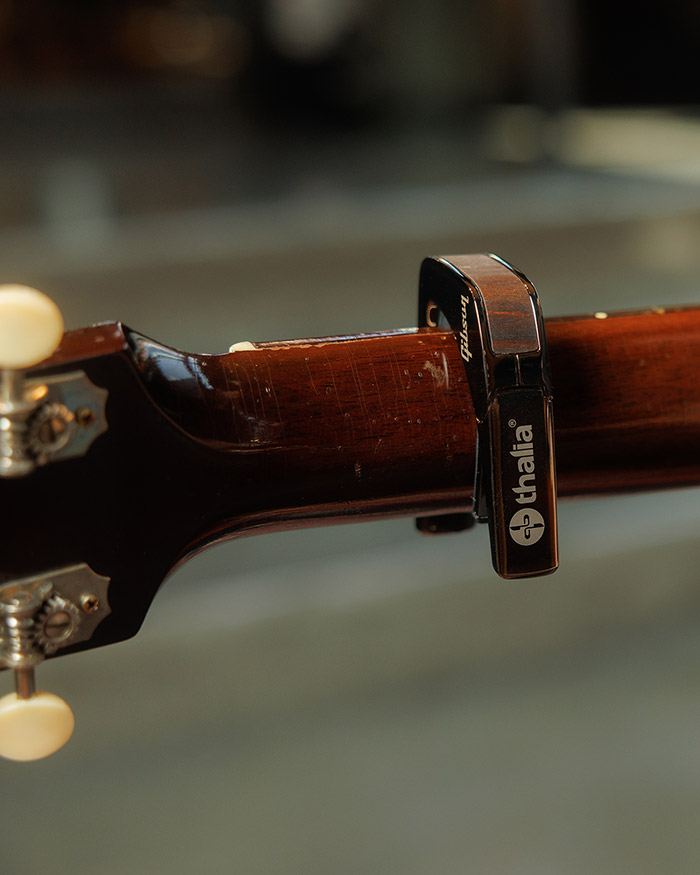Clamp, toggle, and partial capos form the bedrock of capo designs
Whether you’re a beginner guitarist or a pro, you’re likely familiar with the capo. This guitar accessory is the perfect size to throw in your gig bag, hard case, or even your pocket, bringing it everywhere.
But if you’ve only ever had one kind of capo, you may not know there are several types of capos.
In this short guide, we’re discussing the different guitar capo types.
What is a Guitar Capo?
A capo is a small accessory that allows you to change the key of your guitar. The electric or acoustic guitar capo acts almost as an additional finger, barring any fret to facilitate playing in a different key.
By positioning a capo higher up on the fretboard, you can produce higher sounds—all while playing familiar chord shapes, which can be helpful for beginners who are unable to play barre chord shapes.
The History and Evolution of the Capo
Originally, there was only one type of capo. The first known capo, used in the 1700s, was a C-shaped piece of pure brass that lacked padding. (1) Musicians were likely using makeshift capos before then, but those devices are lost to time.
The first officially patented guitar capo came in 1850, when James Ashborn, a luthier from Wolcotville, CT, applied for a “capotasto” patent. (1) This early capo could be tightened on the guitar’s neck for an extra-snug fit.
Over the years, more variations on the capo came to be; by 1896, the Sears Catalog boasted five different style capo options. (1)The 1900s saw the invention of several new types of capos, including some of the versions still in use today. We’ll talk more about each different type later.

Types of Guitar Capos
The world of capos has come a long way since that unpadded, neck-damaging variety from the 1700s. Below are some of the most popular types of modern guitar capos.
Clamp Capos
By far the most common type of capo, the clamp capo combines convenience with quality—you can position them by simply squeezing with one hand. There are two varieties of clamp capos:
- Spring-loaded capos – Also known as the trigger capo, the spring-loaded capo relies on the tension of a spring to press down the guitar strings.
- Adjustable tension capos – These capos have twistable knobs that change how tight the capo is.
Toggle Capos
With a toggle capo, a strap presses the fretpad into the strings. To use a toggle capo, unfasten the strap, place the capo around the guitar neck, then thread the strap through the buckle and pull tight.
Because they require two hands to operate, toggle capos aren’t ideal for live performances.
Partial Capos
A partial capo is unique in that it doesn’t cover all the strings. Instead, partial capos only hold down certain strings, allowing for some interesting chord voicings.
Different partial capos hold down combinations of the following strings:
- The top 3–5 strings
- The bottom 3–5 strings
- The middle 3–4 strings
Do Different Capos Make a Difference?
Yes and no. All capos do more or less the same thing: They press down on your strings, allowing you to change keys at will.
That said, not all capos are created equal. To choose the best guitar capo type, you’ll need to consider what matters most to you.
Sound Quality and Tuning Stability
A capo should press the strings down firmly, but not too hard. It needs to press down firmly enough to ensure that the strings are properly fretted so that they do not buzz, but not so firmly that it pulls the guitar out of tune. That’s why an adjustable tension capo is ideal for sound quality, as you’ll have more control over the tension.
However, a well-made trigger capo also presses down firmly, giving you a crystal-clear sound.

Ease of Use and Adjustability
Once you’ve learned how to use a capo, which type should you go for? For convenience, you can’t go wrong with a spring-loaded trigger capo; it can be easily adjusted with one hand.
That said, if you’re after adaptability, a toggle capo or adjustable tension capo will offer more control.
Durability and Build Quality
In general, having fewer parts means fewer opportunities for something to go wrong. A simple clamp capo or toggle capo is unlikely to break on you, making these the ideal capos for the player on the go.
If you’re concerned about durability, spend a little more on a sturdy, well-made capo. A $20 capo will do the trick, but it may not last your entire career. Invest in a high-quality capo, and you’re all but guaranteed to have it for the rest of your life.
Does Having a Good Capo Matter?
Absolutely. A capo may seem like a simple device, but if you want the best sound, you need a superior capo.
A poor-quality capo can cause muted strings, buzzing sounds, and other performance-affecting issues. Additionally, it may be hard to put on and take off, leading to dead air between songs as you adjust your capo onstage.
There’s Only One Type of Capo You Need: A Gibson Capo
If you’re looking for a high-quality capo, you can’t go wrong with any of our Gibson capos. These beautiful, functional capos come with two rubber fretpads for maximum adjustability to guitars with a different fretboard radius, a microfiber pouch, and a clear jewel case.
Try one for yourself, and see the difference a good capo makes.
Sources:
- Tedium. Capos On The Brain. https://tedium.co/2020/05/26/guitar-capo-history/

